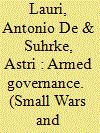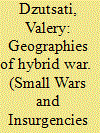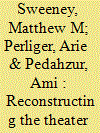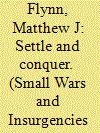| Srl | Item |
| 1 |
ID:
178532


|
|
|
|
|
| Summary/Abstract |
This article examines the genealogy and behavior of the CIA militias in Afghanistan against the backdrop of persistent armed governance whereby a plurality of actors competes over control and rule. The nonaccountable use of force by militias and their volatile alliances increase the extent of armed governance, exacerbating issues of human rights abuses and undermining the possibility of future claims for justice. We discuss the effects of recurrent political violence on the peace talks and the implications for a sustainable peace, the need to include a solution for the role of militias in a peace agreement, and the necessity of ending impunity.
|
|
|
|
|
|
|
|
|
|
|
|
|
|
|
|
| 2 |
ID:
178530


|
|
|
|
|
| Summary/Abstract |
What explains the variation in violence in the internationalized civil conflict? This study identifies such conflict as an adaptation of insurgency warfare by the state. The analysis of the conflict in Eastern Ukraine indicates that violence levels peak in the areas where the preexisting political loyalties for the challenger state were strongest, where the central government of the incumbent state has inadequate access, and where the impact of war on civilians is relatively low. The study also points to the importance of scaling factors for determining the intensity of violence.
|
|
|
|
|
|
|
|
|
|
|
|
|
|
|
|
| 3 |
ID:
178531


|
|
|
|
|
| Summary/Abstract |
The study explores the nexus of violence and mass media, and the ability of terrorists to enhance their influence and resources via effective marketing of their actions. We utilized a dataset of 242 IS propaganda videos in order to examine how the Islamic State employed visual propaganda to enhance the effectiveness of a low-cost, high-impact terrorist campaign, by reconstructing the theater of terror. Our findings illustrate the positive relationship between the IS territorial control and the quality of its media production, thus the IS uses propaganda to develop a relatively low-cost avenue to global media attention. Prior acts of terrorism were risky, high cost, and required news media to cover the incidents. For IS, a steady stream of battle imagery allowed it to develop highly efficient low-cost propaganda. Additionally, we identified associations between the video’s thematic components, including between level of depicted violence and the tendency of the videos to be critical or to include religious symbols, as well as their production value. It reflects the importance that terrorist groups place in maximizing the symbolic impact of their violent videos which intend to depict their military capabilities, and capacity to retaliate against their enemies.
|
|
|
|
|
|
|
|
|
|
|
|
|
|
|
|
| 4 |
ID:
178533


|
|
|
|
|
| Summary/Abstract |
American westward expansion so thoroughly undermined Native people and cultures that it has earned a place in history as the ultimate counterinsurgency success. The creation of a new American reality did not arise from a punitive act of waging war on an adversary so much as from an unkept promise of assimilation of the Native culture into the new nation. This process left all parties swapping missions of insurgent and counterinsurgent, until the young nation no longer needed Natives to enable settlement. Then, conquest arose as an inaccurate label masking a failed military effort to wage ‘total war.’ That narrative was established when the civilian tide of frontiersmen, militia, explorers, and pioneers teamed with soldiers to control ‘Indian country.’ That demographic end state became a broken analogy that dictates American efforts at counterinsurgency today.
|
|
|
|
|
|
|
|
|
|
|
|
|
|
|
|
| 5 |
ID:
178529


|
|
|
|
|
| Summary/Abstract |
This article critically examines how the hybrid warfare concept informs Russian academic and policy debate and how it impacts Russian political and military practice. It explains how the concept of hybrid warfare correlates with the concept of new generation warfare in shaping two vectors in the Russian military policy. The analysis of Russian strategic discourse on hybrid warfare paired with the analysis of some trends in the Russian policy-making argues that the notion of hybrid warfare has become embedded in the thinking of the elites and is now operationalized, including in domestic politics.
|
|
|
|
|
|
|
|
|
|
|
|
|
|
|
|